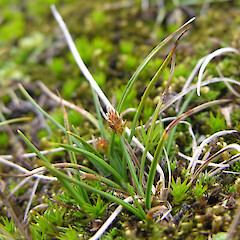Carex pyrenaica var. cephalotes
Common name
mountain sedge
Synonyms
Carex cephalotes F.Muell.
Family
Cyperaceae
Flora category
Vascular – Native
Endemic taxon
No
Endemic genus
No
Endemic family
No
Structural class
Sedges
NVS code
The National Vegetation Survey (NVS) Databank is a physical archive and electronic databank containing records of over 94,000 vegetation survey plots - including data from over 19,000 permanent plots. NVS maintains a standard set of species code abbreviations that correspond to standard scientific plant names from the Ngä Tipu o Aotearoa - New Zealand Plants database.
CARPVC
Current conservation status
The conservation status of all known New Zealand vascular plant taxa at the rank of species and below were reassessed in 2017 using the New Zealand Threat Classification System (NZTCS) – more information about this can be found on the NZTCS website. This report includes a statistical summary and brief notes on changes since 2012 and replaces all previous NZTCS lists for vascular plants.
Please note, threat classifications are often suggested by authors when publications fall between NZTCS assessment periods – an interim threat classification status has not been assessed by the NZTCS panel.
- Conservation status of New Zealand indigenous vascular plants, 2017 . 2018. Peter J. de Lange, Jeremy R. Rolfe, John W. Barkla, Shannel P. Courtney, Paul D. Champion, Leon R. Perrie, Sarah M. Beadel, Kerry A. Ford, Ilse Breitwieser, Ines Schönberger, Rowan Hindmarsh-Walls, Peter B. Heenan and Kate Ladley. Department of Conservation. Source: NZTCS and licensed by DOC for reuse under the Creative Commons Attribution 4.0 International licence.
2017 | Not Threatened
Previous conservation statuses
2012 | Not Threatened
2009 | Not Threatened
2004 | Not Threatened
Distribution
Indigenous. North and South Islands. In the North Island known from Mt Taranaki (Egmont/Taranaki), Ruahine and Tararua Ranges. In the South common throughout the main mountain ranges though scarce in Marlborough. Also present in Australia.
Habitat
Subalpine to alpine cushion and sphagnum bog, tarn and stream margins and damp seepages and flushes within tussock grassland and alpine herbfield.
Wetland plant indicator status rating
Information derived from the revised national wetland plant list prepared to assist councils in delineating and monitoring wetlands (Clarkson et al., 2021 Manaaki Whenua – Landcare Research Contract Report LC3975 for Hawke’s Bay Regional Council). The national plant list categorises plants by the extent to which they are found in wetlands and not ‘drylands’. The indicator status ratings are OBL (obligate wetland), FACW (facultative wetland), FAC (facultative), FACU (facultative upland), and UPL (obligate upland). If you have suggestions for the Wetland Indicator Status Rating, please contact: [Enable JavaScript to view protected content]
FAC: Facultative
Commonly occurs as either a hydrophyte or non-hydrophyte (non-wetlands).
Detailed description
Densely tufted or cushion-forming dark green to bright glaucous green sedges arising from an ascending deeply rooted rhizome. Culms 10–200 × 0.5–1 mm, terete, smooth; basal sheaths light brown or grey-brown. Leaves numerous, usually < culms, 0.5–1.5 mm wide, involute at the base, flattened toward obtuse or subacute apex, plano-convex, margins finely scabrid. Inflorescence solitary, terminal, usually ebracteate. Spike ovoid to oblong, 5–20 × 5–10 mm, male flowers numerous overtopping the numerous females. Glumes mostly < utricle length, ovate, acute, caduceus to deciduous, membranous, red-brown, midrib light brown, margins hyaline. Utricles 2.5–5 × 1 mm, plano-convex, elliptic-lanceolate, strongly reflexed when mature, smooth, glabrous, pale yellow-brown; beak 1 mm long, red-brown, crura oblique, membranous, stipe 1 mm long or absent. Stigmas 2–3. Nut 1.5–2 mm long, oblong, smooth dimorphic; biconvex in flowers with 2 stigmas, subtrigonous in flowers with 3 stigmas.
Similar taxa
Easily distinguished by the unispicate, ebracteate inflorescence this separates this carex from all except C. capillacea Boott from which it differs by its wider leaves, and distinctly coriaceous, shortly stipitate and longer 2.5–4.5 mm long utricles. Carex pyrenaica Wahlenb. var. pyrenaica of Europe, Asia and North America has flowers with mainly 3 stigmas and utricles with markedly longer stipes.
Flowering
October–December
Fruiting
November–May
Life cycle
Nuts surrounded by inflated utricles are dispersed by granivory and wind (Thorsen et al., 2009).
Propagation technique
Easily grown from division of whole plants and from fresh seed. Does best in a pot partially submerged in water. Dislikes humidity and will not tolerant drought.
Etymology
carex: Latin name for a species of sedge, now applied to the whole group.
Where To Buy
Not commercially available
Attribution
Fact Sheet prepared by P.J. de Lange (10 August 2006). Description adapted from Moore and Edgar (1970).
References and further reading
Moore LB, Edgar E. 1970. Flora of New Zealand, Volume II. Indigenous Tracheophyta: Monocotyledones except Gramineae. Government Printer, Wellington, NZ. 354 p.
Thorsen MJ, Dickinson KJM, Seddon PJ. 2009. Seed dispersal systems in the New Zealand flora. Perspectives in Plant Ecology, Evolution and Systematics 11: 285–309.
NZPCN Fact Sheet citation
Please cite as: de Lange, P.J. (Year at time of access): Carex pyrenaica var. cephalotes Fact Sheet (content continuously updated). New Zealand Plant Conservation Network. https://www.nzpcn.org.nz/flora/species/carex-pyrenaica-var-cephalotes/ (Date website was queried)






